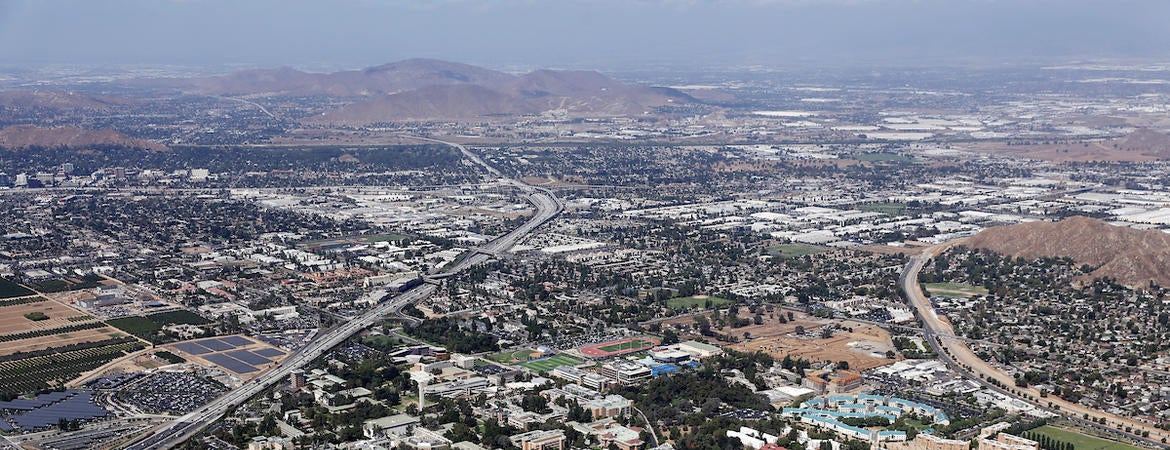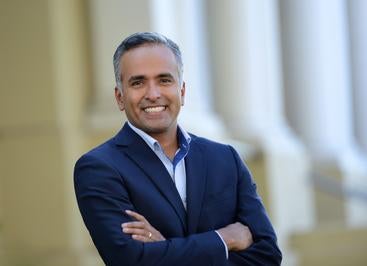
The two-county Inland Empire region is home to more than 4.6 million people and nearly 15,000 nonprofit organizations, and leads the state with the greatest share of nonprofit startups since 2010.
Nonprofits, in many ways, have been a boon for the region, assert the authors of a new report from the Center for Social Innovation at the University of California, Riverside.
“State of Nonprofits in the Inland Empire” is the latest installment in an ongoing series about the region, with previous editions covering immigrants, work, women, and civic engagement. It draws on sources including Internal Revenue Service records, government employment data, foundation giving data, original surveys, and interviews with Inland Empire nonprofit leaders.
The Center for Social Innovation was founded in 2018 by Karthick Ramakrishnan, a professor of public policy and political science at UCR, who continues to serve as the center’s director and leads its research efforts.
“We find that nonprofits are strengthening the region in several key ways, not only in terms of growing good-paying jobs, but also by building coalitions, empowering the local community, and increasing their capacity to serve vulnerable populations,” Ramakrishnan said.
The region’s current share of 14,331 registered nonprofits has grown by about 42% since 2005, with most nonprofits concentrated in cities like Riverside, San Bernardino, and Victorville, as well as in the Coachella Valley. The region has also gained a larger number of nonprofits with annual budgets over $5 million, the report’s authors noted.
Nonprofit jobs in the region have similarly been on the rise, according to numbers from the U.S. Bureau of Labor Statistics, and now represent about 6% of the Inland Empire’s employment.
What’s more, those nonprofit jobs pay significantly higher than other private-sector jobs in the region, although there are clear pay disparities based on the field in which a nonprofit is situated.
For example, “while nonprofit employees in education and health sectors are generally well paid, those working in social assistance to help disadvantaged and vulnerable populations get paid very little,” the researchers wrote.
Disparities are also evident statewide when it comes to foundation investments in nonprofits, according to the researchers. Although giving from state and national foundations to Inland Empire nonprofits has increased dramatically over the past decade, the region still lags behind others in California when it comes to dollars received.
As of 2016, foundation giving to Inland Empire nonprofits reached $136 million. Yet neighboring Orange County, which has a resident population about 30% smaller than that of the Inland Empire, received $439 million, while another neighbor, Los Angeles County, received $2.77 billion.
“Thus, even though state and national foundations often aspire to improve social conditions and help the most vulnerable and marginalized groups, vast disparities in foundation giving actually end up reinforcing regional disparities between inland and coastal areas, rather than mitigating them,” the researchers wrote.
“Making matters worse, internal giving from foundations within the Inland Empire to nonprofits within the Inland Empire is far lower than in other regions,” they added, noting that 92% of foundation giving to nonprofits in the region comes from outside the Inland Empire.
As a result, evening the playing field will require “greater engagement with private donors who care about the future of Southern California, as well as with statewide and national foundations,” said Ramakrishnan, who also serves on the board of The California Endowment, a major statewide foundation.
The report’s co-authors suggest a major bright spot for nonprofits in the region has been their unification around outreach and engagement activities for the 2020 U.S. census.
Since 2018, more than 80 Inland Empire nonprofits and government agencies have collaborated to raise awareness of the census among hard-to-count communities, in particular.
Investments in regional census outreach from public and private sources have totaled $5.2 million, resulting in an unprecedented joint effort between Riverside and San Bernardino counties to ensure an accurate count.
“Continued investments in these partnerships will deepen cross-sector collaboration and make inclusive regional planning a reality,” the researchers wrote.
They warn, however, that the coronavirus crisis could have severe impacts on the region’s nonprofit sector, potentially undoing much of the progress made in the leadup to the census.
“In some respects, the crisis is accelerating certain types of innovation, including remote canvassing, community building, and collaborative problem solving,” the researchers wrote. “However, if stark disparities in funding continue to persist between coastal and inland California, we could see many of the decade’s gains wiped out.”
With the aim of helping nonprofit leaders and philanthropists better understand and address the effects of the coronavirus crisis on the region, the Center for Social Innovation recently launched two new publicly accessible tools.
The first, IE COVID Response, is the result of a partnership between the center and the Inland Empire Community Foundation, which largely led census outreach efforts for nonprofits and community organizations in the region.
Updated on a frequent and ongoing basis, IE COVID Response features information on resources, needs, and opportunities in the region related to community health, economic vitality, social belonging, and equity.
Additionally, visitors to the site will find the center’s new Inland Empire COVID Monitor, an interactive tracking tool with detailed maps of COVID-19 cases by city. The platform also features information on vulnerable populations and health care capacity, bringing to light regional disparities in whom the virus is affecting and how it’s being treated.
In the meantime, the center has begun to organize weekly video briefings for leaders from regional nonprofits — as well as representatives from the Office of the Governor and county offices — to discuss policy updates, funding opportunities, and grassroots community needs.
Many Inland Empire nonprofits already operated on lean budgets before the crisis hit, the researchers noted in their report. By hosting the briefings, the center hopes to further the relationship-building that stemmed from regional census outreach and ensure vulnerable communities receive needed aid.
Still, the researchers added, as the crisis abates, “state budgets and philanthropic investments will need to be much more equitable across regions … in order to ensure that nonprofits and communities in this rapidly growing region get back on their upward trajectory.”
More about the Center for Social Innovation: Housed within UCR’s School of Public Policy, the Center for Social Innovation aims to provide a credible research voice that spurs civic leadership and policy innovation. The center also aims to integrate researchers, community organizations, and civic stakeholders in collaborative projects and long-term partnerships that boost collective impact. Importantly, the Center seeks to shift away from a “problem” narrative to an “opportunity” narrative for marginalized communities and localities.
Header image by Paul Rodriguez of Rodriguez Consulting Group




